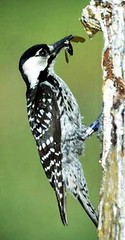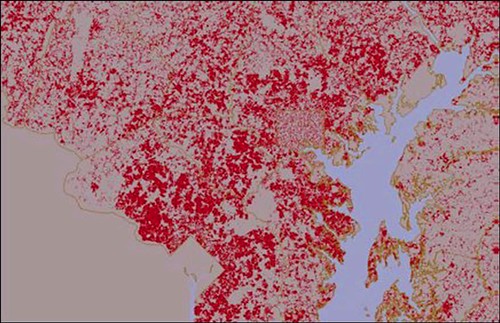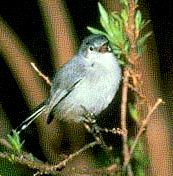Bye, bye, birdie

Posted November 30, 2007 at 7:27PM
 Earlier this week, the National Audubon Society and the American Bird Conservancy released a new report warning that more than a quarter of the bird species in the US are in danger of extinction. Suburban sprawl is among the principal threats, as are global warming, agriculture and natural resources development. The red-cockaded woodpecker, golden-cheeked warbler, Florida scrub-jay, and the California gnatcatcher are among way too many species listed as imperiled by the two organizations.
Earlier this week, the National Audubon Society and the American Bird Conservancy released a new report warning that more than a quarter of the bird species in the US are in danger of extinction. Suburban sprawl is among the principal threats, as are global warming, agriculture and natural resources development. The red-cockaded woodpecker, golden-cheeked warbler, Florida scrub-jay, and the California gnatcatcher are among way too many species listed as imperiled by the two organizations.
This is obviously bad news.
Unfortunately, it is consistent with the threat to the entire range of wildlife and plant species whose habitat is being irrevocably lost or fragmented due to runaway development. An earlier report issued by the National Wildlife Federation, Smart Growth America, and NatureServe found that nearly a third of the nation’s animal and plant species are at risk, and that as many as 500 species that once lived in the US may already be extinct. That report concluded that “the primary threat to most of these species is the destruction or degradation of the habitats on which they depend. While many human activities—from agriculture to military training—can alter natural habitats, the conversion of green space to urban and suburban uses is the fastest growing threat to the nation’s wild species.” The report cites California research demonstrating that, in that state, sprawl is the leading cause of imperilment.
 Although this is discouraging, it shouldn’t be surprising. Check out the two maps of Maryland accompanying this post. Look first at the one just to the left, with the yellow detail. The large blue body of water is the Chesapeake Bay; the square-ish boundary in the center is the city of Baltimore. Washington, DC’s suburbs are to the southwest of Baltimore. The detail in yellow represents the locations of all the building permits issued from 1900-1960. Not too bad, really. There's a lot of open space left.
Although this is discouraging, it shouldn’t be surprising. Check out the two maps of Maryland accompanying this post. Look first at the one just to the left, with the yellow detail. The large blue body of water is the Chesapeake Bay; the square-ish boundary in the center is the city of Baltimore. Washington, DC’s suburbs are to the southwest of Baltimore. The detail in yellow represents the locations of all the building permits issued from 1900-1960. Not too bad, really. There's a lot of open space left.
But now look at the one below, in which the red detail represents the location of all the building permits issued from 1961-1997. What a dramatic difference. Is it any wonder that we have critters who aren’t doing too well?
 I wish the Audubon – American Bird Conservancy report this week had been more aggressive in identifying the smart growth solutions to the chaotic habitat degradation caused by sprawl. Unfortunately, it never quite gets to the issue. But the NWF report is unambiguous on the subject: “if the U.S. is to protect its current array of plant and animal species for future generations, the nation must plan carefully to guide development so that it leaves life-sustaining green infrastructure intact.” And it identifies a six-point strategy, including the establishment of urban growth boundaries, for doing so.
I wish the Audubon – American Bird Conservancy report this week had been more aggressive in identifying the smart growth solutions to the chaotic habitat degradation caused by sprawl. Unfortunately, it never quite gets to the issue. But the NWF report is unambiguous on the subject: “if the U.S. is to protect its current array of plant and animal species for future generations, the nation must plan carefully to guide development so that it leaves life-sustaining green infrastructure intact.” And it identifies a six-point strategy, including the establishment of urban growth boundaries, for doing so.
At NRDC, we do a lot of work to save endangered landscapes and wild places, and we do a lot of work to promote the smart growth solutions to suburban sprawl. We also do some endangered species work, and we strongly support those organizations that focus on it, including NWF, Audubon, Defenders of Wildlife, and others.  With respect to endangered birds, my colleague Joel Reynolds did pioneering work for years to protect the habitat of the California gnatcatcher, and made a difference. We will being doing more for wildlife, and I hope smart growth will play a major role in our strategy.
With respect to endangered birds, my colleague Joel Reynolds did pioneering work for years to protect the habitat of the California gnatcatcher, and made a difference. We will being doing more for wildlife, and I hope smart growth will play a major role in our strategy.
Incidentally, “Bye, Bye, Birdie” was my high school play, a musical. I wasn’t in it, and to my classmates I say, you’re welcome.